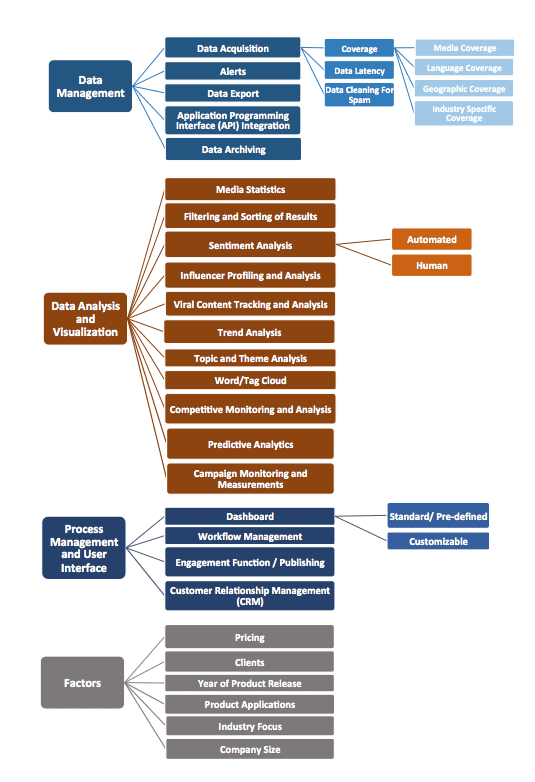Social Media Monitoring offers opportunities for a more strategic approach
Are you still one of those businesses that are using social media monitoring (SMM) tools and services tactically or maybe not sure if you are using the right social media tool(s) for your business needs? By tactical SMM I mean the common use of social media tools for simply analyzing daily activities across specific social media to track online conversations around your brand, responding to negative or positive comments, or evaluating your marketing campaigns.
If so, you should be aware that SMM also offers opportunities for a more strategic approach.
In order to realize a long term value from SMM you need to integrate SMM with other business processes. This may include measuring the strategic business impact of social media marketing, strengthening initiatives for social customer engagement, expanding strategies for increasing retention and revenue from current customers, implementing social media campaigns to acquire new customers, and so forth.
Businesses across all industries continue to invest into social media programs such as employee advocacy, social selling, social recruiting, social advertising, etc. and employing various Social Media Monitoring (SMM) technologies and services to monitor and solicit public opinions about their brand and products, shape their online presence and develop strategies to efficiently engage and harness the social paradigm.
To measure the value of their social media activities, they should look at the overall results they are generating, and carefully examine how social media was engaged in increasing their bottom lines through growing revenue and increasing efficiency. The chart below illustrates some of the key ways the social media can affect your business performance.
For instance, you can shorten your company’s sales cycle and accelerate revenue by generating multiple impressions for your online content across the vast social media channels and build and leverage the credibility, trust and relationships to win a prospect’s business. This can be significantly augmented by successfully integrating your social media and traditional marketing strategies at every stage of the buying process. Similarly, in terms of customer services, you can use SMM and management tools with strong workflow management to improve customer services and customer satisfaction by increasing resolution rate and lowering resolution time outside call center, as well as increase brand loyalty and awareness by actively engaging with customers and addressing their questions and concerns. Your relationship with customers and their experience with your brand should be of the utmost importance.
If used right, social intelligence offered by SMM tools can create true business value for your business by supporting every area of your business: from understanding consumers’ needs and behaviours, competitive landscape, creating risk management plans, increasing customer experience and satisfaction, to executing product development and campaigns, and building long term and profitable relationships with your customers.
Choosing the Right Social Media Monitoring Tools for Strategic Evaluation
There are many social media monitoring, intelligence, analytics, marketing and management tools on the market and making an educated choice about which tool(s) can best address your specific business needs and justify your social media investment has become a complex and multifaceted process.
The number and quality of SMM tools available in the market has increased, with the SMM technology industry maturing rapidly through innovation and acquisitions by large technology companies and the emergence of new tools, delivering unique and more sophisticated analytical capabilities and more personalized engagement. This has created a highly complex and diverse landscape of SMM technologies with the top vendors developing features beyond monitoring, listening, or social media management, and converging gradually with other types of platforms such as content management, customer experience or social relationship platforms.
According to Ideya’s Report on Social Media Monitoring Tools and Services, there is no single SMM tool or service provider that can effectively measure and address all aspects of social media. For that reason, most businesses are currently using multiple social media tools across different functional areas, geographies, as they require a slightly different approach and view of the social media space in order to address their specific analysis, engagement and business needs.
SMM technology providers aim at delivering unique SMM solutions in terms of technologies they apply, key product features and pricing they offer. This often presents challenges to businesses that are just embarking on SMM or upgrading their existing SMM activities and it is difficult to make an informed decision without having an overview of the current options and new trends. For that reason, Ideya has compiled information about key product features of 200 tools and services including:
- Data management features such as data coverage (media, language, geographic and industry coverage), data latency, alerts (standard or threshold alerts), data export capabilities, Application Programming Interface (API) integration options, and data archiving,
- Data analysis and visualization features, including key metrics, sentiment analysis (metrics and language coverage), influencer profiling and analysis, viral content tracking and analysis, trend analysis, topic and theme analysis, word/tag cloud, competitive monitoring and analysis, predictive analytics, campaign management and measurements,
- Process management and user interface, including dashboard (standard or customizable), workflow management, engagement function, publishing function (e.g., content creation and/or curation, editorial calendar, time optimization for post scheduling, etc.), Client Relationship Management (CRM), and
- Factors influencing purchasing decisions, including pricing, key clients, product applications, industry focus, client support, company size and year when the tool or service was made publicly available.
We expect that these aspects are important for outlining the SMM strategy and selecting specific providers.
The Tool Key Features and Factors Impacting Selection Process
As discussed in the Report, understanding the data management, data analysis and visualization features as well as process management and user interface of a specific tool is of the utmost importance, as well as understanding what differentiates it from its competitors.
Nevertheless, you should also understand key social media monitoring functions and product applications, as well as take into consideration other factors influencing purchasing decisions such as
pricing, product and service availability, vendor’s industry focus, its ability to innovate and quickly adapt as social media landscape changes, and possibly review SMM vendor’s reference client listing, which demonstrate vendor’s professional experience and credibility.
A summary of some key findings from the SMM Tools and Services Report can be found in our most recent Presentation (included below) and SMM Tools and Services Report Excerpts that have been recently published on the SlideShare.net platform. Enjoy reading and do leave a comment or questions if you want to know more about how to better use social media monitoring tools for your business!




 Thanks to Luisa Milic, M.Sc. for sharing her thoughts and opinions in this blog post. Luisa is the Founder and Director of
Thanks to Luisa Milic, M.Sc. for sharing her thoughts and opinions in this blog post. Luisa is the Founder and Director of